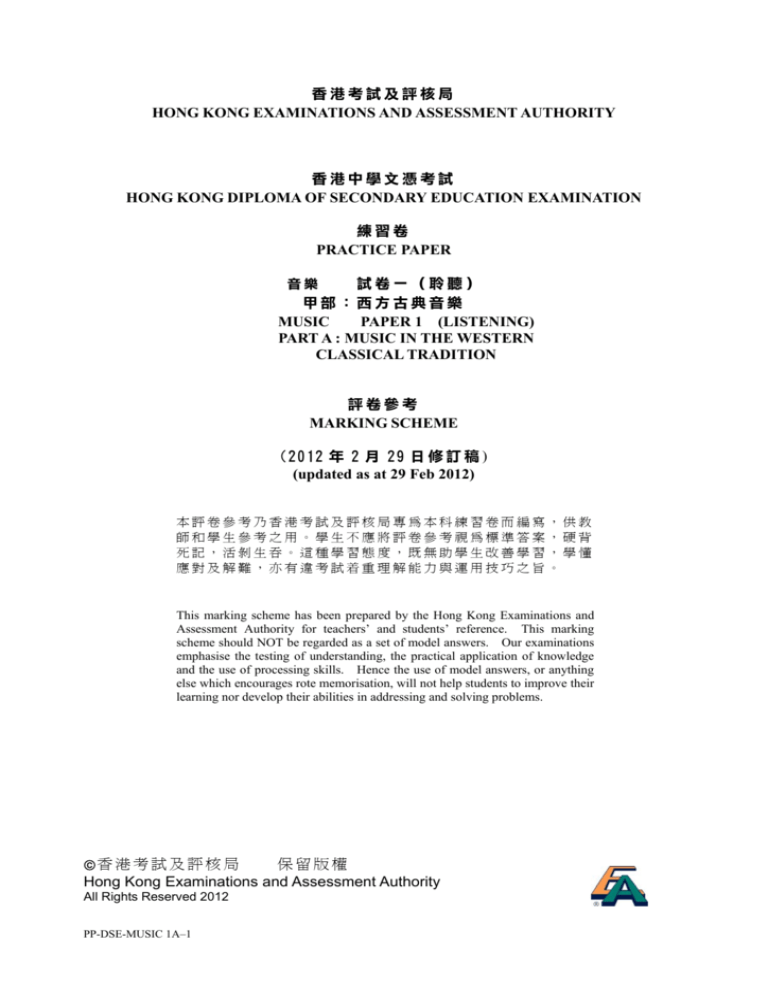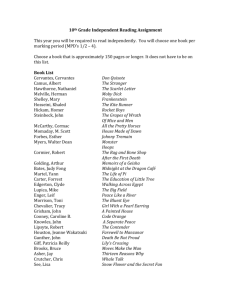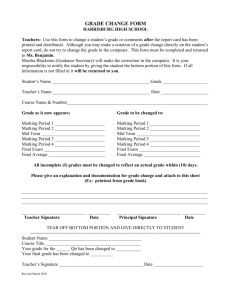
香港考試及評核局
HONG KONG EXAMINATIONS AND ASSESSMENT AUTHORITY
香港中學文憑考試
HONG KONG DIPLOMA OF SECONDARY EDUCATION EXAMINATION
練習卷
PRACTICE PAPER
試卷一(聆聽)
甲部:西方古典音樂
MUSIC
PAPER 1 (LISTENING)
PART A : MUSIC IN THE WESTERN
CLASSICAL TRADITION
音樂
評卷參考
MARKING SCHEME
(2012 年 2 月 29 日 修 訂 稿 )
(updated as at 29 Feb 2012)
本評卷參考乃香港考試及評核局專為本科練習卷而編寫,供教
師和學生參考之用。學生不應將評卷參考視為標準答案,硬背
死記,活剝生吞。這種學習態度,既無助學生改善學習,學懂
應對及解難,亦有違考試着重理解能力與運用技巧之旨。
This marking scheme has been prepared by the Hong Kong Examinations and
Assessment Authority for teachers’ and students’ reference. This marking
scheme should NOT be regarded as a set of model answers. Our examinations
emphasise the testing of understanding, the practical application of knowledge
and the use of processing skills. Hence the use of model answers, or anything
else which encourages rote memorisation, will not help students to improve their
learning nor develop their abilities in addressing and solving problems.
保留版權
©香 港 考 試 及 評 核 局
Hong Kong Examinations and Assessment Authority
All Rights Reserved 2012
PP-DSE-MUSIC 1A–1
Marking Scheme
General Notes for Teachers on Marking
1.
This marking scheme has been updated, with revisions made after the scrutiny of actual samples of student
performance in the practice papers. Teachers are strongly advised to conduct their own internal
standardisation procedures before applying the marking schemes. After standardisation, teachers should
adhere to the marking scheme to ensure a uniform standard of marking within the school.
2.
The marking scheme may not exhaust all possible answers for each question. Teachers should exercise
their professional discretion and judgment in accepting alternative answers that are not in the marking
scheme but are correct and well reasoned.
3.
In questions asking for a specified number of reasons or examples etc. and a student gives more than the
required number, the extra answers should not be marked. For instance, in a question asking students to
provide two examples, and if a student gives three answers, only the first two should be marked.
4.
The following symbols are used:
/
A single slash indicates an acceptable alternative within an answer.
+
A plus sign indicates that there are two pieces of information necessary to be awarded the
point: the first piece of information comes before the plus sign and the second after.
PP-DSE-MUSIC 1A–2
Part A Western Classical Music (50 marks)
[ ] indicates the time interval where the music is being extracted
1.
Marks
Excerpt 1. J. Haydn, String Quartet in Eb major, Op.33, No.2 (The Joke) [0:00 – 0:39]
Excerpt 2. A. Schoenberg, Pierrot lunaire
(Total 8)
[0:00 – 0:56]
Excerpt 3. J.S. Bach, Brandenburg Concerto No.4 in G Major, BWV 1049: III. Presto
[0:00 – 0:34]
Excerpt 4. R. Schumann, Mondnacht, Op.39, No.5 Lied
[0:00 – 1:25]
Excerpt 1
Period :Classical Period
Time Signature: 6/8
1, 1
Excerpt 2
Period :Twentieth Century
Vocal technique:
1, 1
/ modern
Sprechstimme (spoken voice) /
Sprechgesang (spoken song)
2.
Excerpt 3
Period :Baroque Period
Texture: polyphony
1, 1
Excerpt 4
Period :Romantic Period
Genre : lieder
1, 1
Excerpt 5
J.S. Bach, Mass in B minor, “Crucifixus” (opening)
[0:00 –1:14]
(Total 10)
(a)
Imitation / suspension / anticipation
(b)
4-bar Ostinato / Ground bass;
1
Chromatic descending writing
1
(c)
Mass
1
(d)
Refer to the score
4
(e)
Correct notes
Marks
9
4
7–8
3
4–6
2
1–3
1
Dominant (V)
PP-DSE-MUSIC 1A–3
1,1
1
Orchestra
Reduction
Score
2d
2d
PP-DSE-MUSIC 1A–4
2e
Marks
3.
Excerpt 6
Olivier Messiaen, Quartet for the End of Time, I. Liturgie de crystal
(Total 12)
[music is played according to the scores indicated]
(a) Any two of the following answers:
1, 1
Violin / clarinet / cello / piano
(b)
PP-DSE-MUSIC 1A–5
Box P
Trill
1
Box Q
Harmonics
1
Box R
Staccato / détaché
1
Box S
Glissando / portamento
1
Marks
2
(c) (i)
(ii) The notes start a semiquaver later than the original version.
The first quaver rest should be a semiquaver rest. All subsequent rhythms should then be
regrouped accordingly.
PP-DSE-MUSIC 1A–6
1
1
Marks
(d) Twentieth century / modern
1
Any one of the following:
- Any answers related to atonality
- each instrument plays independently with its own pitch and rhythmic materials
4.
Excerpt 7 George Frideric Handel, Julius Caesar, “Tyrant, avoid my sight” [0:00 – 1:34]
Excerpt 8 Giacomo Puccini, Madama Butterfly, “Con onor muore”
[0:00 – 2:01]
Excerpt 7
Excerpt 8
Dynamics
Limited dynamic range
Contrasting dynamic range
Texture
Homophony
Homophony
Orchestration
• Chamber/medium sized
orchestra
• Use of harpsichord
• Prominent string sonority
• Uses figure bass/basso continuo
•
•
•
•
Harmony
Diatonic harmony
Chromatic harmony
Melody
• Sequential writing
• Descending scale
• Featuring coloratura soprano in
high tessitura
• Expressive and emotional
singing
Text-setting
• Mostly syllabic and sometimes
melismatic
• Syllabic
Vigorous string passage
Effective use of brass
Effective use of percussion
Use of string pizzicato
Note:
- Candidates should write the answers in prose.
- Two marks can be awarded for each correct description and comparison of the two excerpts.
PP-DSE-MUSIC 1A–7
1
(Total 20)
香港考試及評核局
HONG KONG EXAMINATIONS AND ASSESSMENT AUTHORITY
香港中學文憑考試
HONG KONG DIPLOMA OF SECONDARY EDUCATION EXAMINATION
練習卷
PRACTICE PAPER
音樂
試卷一(聆聽)
乙部:中國器樂、粵劇音樂、
本地及英美流行音樂
MUSIC PAPER 1 (LISTENING)
PART B : CHINESE INSTRUMENTAL MUSIC,
CANTONESE OPERATIC MUSIC,
LOCAL AND WESTERN
POPULAR MUSIC
評卷參考
MARKING SCHEME
(2012 年 2 月 29 日 修 訂 稿 )
(updated as at 29 Feb 2012)
本評卷參考乃香港考試及評核局專為本科練習卷而編寫,供教
師和學生參考之用。學生不應將評卷參考視為標準答案,硬背
死記,活剝生吞。這種學習態度,既無助學生改善學習,學懂
應對及解難,亦有違考試着重理解能力與運用技巧之旨。
This marking scheme has been prepared by the Hong Kong Examinations and
Assessment Authority for teachers’ and students’ reference. This marking
scheme should NOT be regarded as a set of model answers. Our examinations
emphasise the testing of understanding, the practical application of knowledge
and the use of processing skills. Hence the use of model answers, or anything
else which encourages rote memorisation, will not help students to improve their
learning nor develop their abilities in addressing and solving problems.
保留版權
©香 港 考 試 及 評 核 局
Hong Kong Examinations and Assessment Authority
All Rights Reserved 2012
PP-DSE-MUSIC 1B–1
Marking Scheme
General Notes for Teachers on Marking
1.
This marking scheme has been updated, with revisions made after the scrutiny of actual samples of student
performance in the practice papers. Teachers are strongly advised to conduct their own internal
standardisation procedures before applying the marking schemes. After standardisation, teachers should
adhere to the marking scheme to ensure a uniform standard of marking within the school.
2.
The marking scheme may not exhaust all possible answers for each question. Teachers should exercise
their professional discretion and judgment in accepting alternative answers that are not in the marking
scheme but are correct and well reasoned.
3.
In questions asking for a specified number of reasons or examples etc. and a student gives more than the
required number, the extra answers should not be marked. For instance, in a question asking students to
provide two examples, and if a student gives three answers, only the first two should be marked.
4.
The following symbols are used:
/
A single slash indicates an acceptable alternative within an answer.
+
A plus sign indicates that there are two pieces of information necessary to be awarded the
point: the first piece of information comes before the plus sign and the second after.
PP-DSE-MUSIC 1B–2
Part B
Chinese Instrumental Music, Cantonese Operatic Music, Popular Music (50 marks)
[ ] indicates the time interval where the music is being extracted
1.
《 五 梆 子 》 第 一 段 ( Music performed by 馮 子 存 )
(Total 6)
Bangdi
1
(b)
trill
1
flutter-tonguing
1
Zhi
The ensemble plays the same melody with the dizi in a heterophonic texture.
When the dizi plays a long note at the end of each phrase, the ensemble answers it with
short melodic figures.
1
1
1
(d)
五 重 奏 《 漁 舟 唱 晚 》 (guzhen, yangqin, pipa, erhu, xiao)
[1:34 – 3:33]
(Total 7)
(a)
Any three of the following answers:
․ Sequence
․ Melody repeated
․ Downward melodic contour; first phrase ends on the note zhi, moving downward
along the pentatonic scale to the note zhi an octave below.
․ When the sequence is repeated, the guzheng plays an answering phrase against the
erhu which plays the original pentatonic melody.
3
(b)
․
1
․
(c)
3.
[0:00 - 1:00]
(a)
(c)
2.
Marks
The melody can be divided into two halves. The erhu plays the main melody in
the first half, joined by the pipa in the second half, with the yangqin and guzheng
playing accompaniment.
When the melody is repeated, the xiao plays the main melody throughout the
whole section. All the other four instruments, the erhu, pipa, guzheng, yangqin,
play the accompaniment, creating a contrapuntal texture.
The main melody is first presented in homophonic texture and changed to polyphonic
texture when repeated.
Doming Lam’s Autumn Execution, Section 3, 「 叫 冤 聲 , 動 地 又 驚 天 」
1
2
(Total 7)
林樂培《秋決》第三段「叫冤聲,動地又驚天」
(a)
Any four of the following answers:
․ Bowed strings playing a 3-note melodic figure in free rhythms at the beginning.
․ Tone clusters played by strings.
․ Middle section shifted to homophonic texture with regular rhythmic pulse.
․ 3-note figure played by winds, upper bowed strings and plucked strings.
․ Lower strings play in ostinato.
․ Pitch sliding
4
(b)
․
․
․
1
1
1
Gongs of different sizes
Providing accents to the homophonic section.
Echoing the orchestra’s 3-note figure.
PP-DSE-MUSIC 1B–3
Marks
4.
《 柳 毅 傳 書 . 龍 女 洞 房 》 Sung by 李 寶 瑩
[music is played according to the lyrics indicated]
(Total 8)
(a)
Fanxian shiziju zhongban
1
(b)
The vocal part begins each phrase without accompaniment and is followed by other
instruments in the style of zhuiqiang; instrumental parts imitate the vocal melody and
also add bridges between vocal phrases.
3
(c)
破
liu
1
天
wu
1
諧
che
1
搖
gong
1
《 再 世 紅 梅 記 》 Sung by 任 劍 輝
[music is played according to the lyrics indicated]
5.
(a)
仿 ○
似 藍橋會○
無 ○
語 暗情通○
敢 ○
信 一夜相思兩處同
○
(Total 7)
3
(Zero mark if all the characters are circled)
6.
(b)
A
1
(c)
Instrument: yehu / guzheng / xiao (any 2)
2
Reason: These are the instruments used to accompany nanyin .
1
“Hound Dog” Elvis Presley
[whole piece]
(a)
Any three of the following answers:
․ Each line is set to 4 bars of music
․ The first two lines are identical, which is typical of a 3-line verse blues pattern.
․ The lyrics “You ain’t nothin’ but a” in Lines 1 and 2, and “well, you ain’t” in Line
3 function as pick-ups.
․ The first beat of each 4-bar phrase in the blues pattern falls on “hound” in Lines 1
and 2, and “never” in Line 3.
(b)
7.
Any two of the following answers:
․ Elvis imitated the vocal style of African-American singers, which sounded “wild”
to his audience in the 1950s.
․ He used the upper range of his baritone and chest voice, which made the music
sound more exciting.
․ He pronounced some words to give the singing an uneducated, rural and
American south impression.
《 夜 雨 聲 》 Sam Hui
[whole piece]
(a)
I
(b)
Any two of the following answers:
․ Every phrase begins on the fourth beat.
․ Each phrase is 2 bars long.
․ The end of each phrase usually falls on the first beat of the bar.
․ Usually one note is set to one word, occasionally two notes are set to one word.
(c)
Verse – Verse – Chorus – Instrumental bridge – Verse – Chorus (last line repeated)
(A1) (A2)
(B)
(A)
(A2)
(B)
PP-DSE-MUSIC 1B–4
(Total 5)
3
2
(Total 10)
1
2x2
3
(d)
Any two of the following answers:
․ Drum set provides the regular rhythm synthesiser.
․ Use of synthesiser (or electronic piano).
․ Naming some ways of combining instruments.
PP-DSE-MUSIC 1B–5
Marks
2






